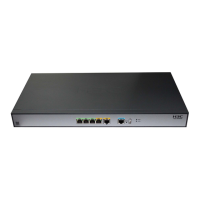856
undo port-mapping application application-name port port-number [ protocol protocol-name ]
host { ip | ipv6 } start-ip-address [ end-ip-address ] [ vpn-instance vpn-instance-name ]
Default
An application protocol is mapped to a well-known port.
Views
System view
Predefined user roles
network-admin
Parameters
application application-name: Specifies an application protocol by its name, a case-insensitive
string of 1 to 63 characters. The names invalid and other are not allowed.
port port-number: Specifies a port by its number, in the range of 0 to 65535.
protocol protocol-name: Specifies a transport layer protocol by its name, including:
• dccp: Specifies DCCP.
• sctp: Specifies SCTP.
• tcp: Specifies TCP.
• udp: Specifies UDP.
• udp-lite: Specifies UDP-Lite.
{ ip | ipv6 } start-ip-address [ end-ip-address ]: Specifies a range of IPv4 or IPv6 addresses. The ip
keyword specifies the IPv4 addresses, and the ipv6 keyword specifies the IPv6 addresses. To
specify only one IP address, provide only the start IP address. To specify a range of IP addresses,
provide both the start and end IP addresses, and make sure the end IP address is bigger than the
start IP address.
vpn-instance vpn-instance-name: Specifies an MPLS L3VPN instance by its name, a
case-sensitive string of 1 to 31 characters. If you configure a mapping for the public network, do not
specify this option.
Usage guidelines
APR uses IP address-based host-port mappings to recognize packets. A packet is recognized as an
application protocol packet when it matches all the following conditions in a mapping:
• The packet is destined for the specified IP address or IP subnet in the mapping.
• The packet's destination port matches the specified port in the mapping.
• The transport layer protocol that encapsulates the packet matches the specified transport layer
protocol if you specify a transport layer protocol in the mapping.
No overlapping of IP addresses is tolerable for the host-port mappings configured with the same
application protocol, port number, and transport layer protocol.
If two port mappings are configured with the same port number, transport layer protocol, and IP
address or IP address ranges, but with different application protocols, the most recent configuration
takes effect.
A mapping with the transport layer protocol specified has a higher priority than one without it.
Examples
# Create a mapping of port 3456 to FTP for the IPv4 packets sent to the host at 1.1.1.1 to 1.1.1.10.
<Sysname> system-view
[Sysname] port-mapping application ftp port 3456 host ip 1.1.1.1 1.1.1.10
# Create a mapping of port 3456 to FTP for the IPv6 packets sent to 1::1.

